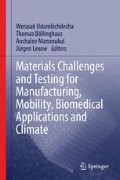Abstract
Two different direct write technologies, Direct Write Paste (DWP) and Direct Write Thermal Spray (DWTS), and the general material challenges related to these technologies are described in this paper. These new technologies open new routes to produce highly functional products that can be tailored and customised according to the demands of the applications. The DWP process is based on dispensing paste-like materials through a tip onto a substrate. Depending on the paste material, either 2 or 3 dimensional structures can be printed. The DWTS technique is based on thermal spraying, which is a spray process where the powder material is accelerated in molten form and impinged onto a surface. Products made using DWTS are especially targeted at harsh environment solutions. Results related to development of printable materials and printed products are presented.
Access this chapter
Tax calculation will be finalised at checkout
Purchases are for personal use only
Preview
Unable to display preview. Download preview PDF.
References
Ahn BY, Shoji D, Hansen C, Hong E, DunandDC Lewis JA (2010) Printed Origami Structures.Adv Mater 1-4
Bullard JW, Jennings HM, Livingston RA, Nonat A, Scherer GW, Schweitzer JS, Scrivener KL, Thomas JJ (2011) Mechanisms of cement hydration. Cem. Concr. Res 41(12): 1208-1223
Lewis JA(2006)Direct ink writing of 3D functional materials. AdvFunct Mater 16: 2193–2204
Liu C, Shen W (1997) Effect of crystal seeding on the hydration of calcium phosphate cement. J. Mater. Sci. Mater. Med. 8 (12): 803-807
Sampath S, Longtin J, Gambino R, Herman H, Greenlaw R Tormey E(2002) Direct-write thermal spray of multilayer electronics and sensor structures. In: Pique A, Chrisey DB Direct-Write Technologies for Rapid Prototyping Applications: Sensors, Electronics, and Integrated Power Sources. Academic Press, USA 261-302
Sampath S (2010) Thermal Spray Applications in Electronics and Sensors: Past, Present, and Future. J. Therm. Spray Technol.19(5): 921–949
Thomas JJ, Jennings HM, Chen JJ (2009) Influence of Nucleation Seeding on the Hydration Mechanisms of Tricalcium Silicate and Cement. J. Phys. Chem. C. 113 (11): 4327-4334
United States Patent, US 6,576,861 B2 (2003) Method and apparatus for fine feature stray deposition. 20p
Author information
Authors and Affiliations
Editor information
Editors and Affiliations
Rights and permissions
Copyright information
© 2014 Springer International Publishing Switzerland
About this chapter
Cite this chapter
Metsä-Kortelainen, S. et al. (2014). Material Challenges in the Manufacturing of Tailored Structures with Direct Write Technologies. In: Udomkichdecha, W., Böllinghaus, T., Manonukul, A., Lexow, J. (eds) Materials Challenges and Testing for Manufacturing, Mobility, Biomedical Applications and Climate. Springer, Cham. https://doi.org/10.1007/978-3-319-11340-1_6
Download citation
DOI: https://doi.org/10.1007/978-3-319-11340-1_6
Published:
Publisher Name: Springer, Cham
Print ISBN: 978-3-319-11339-5
Online ISBN: 978-3-319-11340-1
eBook Packages: Chemistry and Materials ScienceChemistry and Material Science (R0)

